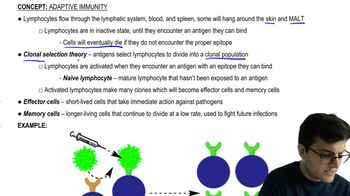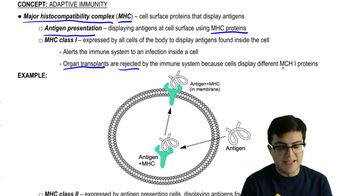Table of contents
- 1. Introduction to Biology2h 42m
- 2. Chemistry3h 40m
- 3. Water1h 26m
- 4. Biomolecules2h 23m
- 5. Cell Components2h 26m
- 6. The Membrane2h 31m
- 7. Energy and Metabolism2h 0m
- 8. Respiration2h 40m
- 9. Photosynthesis2h 49m
- 10. Cell Signaling59m
- 11. Cell Division2h 47m
- 12. Meiosis2h 0m
- 13. Mendelian Genetics4h 44m
- Introduction to Mendel's Experiments7m
- Genotype vs. Phenotype17m
- Punnett Squares13m
- Mendel's Experiments26m
- Mendel's Laws18m
- Monohybrid Crosses19m
- Test Crosses14m
- Dihybrid Crosses20m
- Punnett Square Probability26m
- Incomplete Dominance vs. Codominance20m
- Epistasis7m
- Non-Mendelian Genetics12m
- Pedigrees6m
- Autosomal Inheritance21m
- Sex-Linked Inheritance43m
- X-Inactivation9m
- 14. DNA Synthesis2h 27m
- 15. Gene Expression3h 20m
- 16. Regulation of Expression3h 31m
- Introduction to Regulation of Gene Expression13m
- Prokaryotic Gene Regulation via Operons27m
- The Lac Operon21m
- Glucose's Impact on Lac Operon25m
- The Trp Operon20m
- Review of the Lac Operon & Trp Operon11m
- Introduction to Eukaryotic Gene Regulation9m
- Eukaryotic Chromatin Modifications16m
- Eukaryotic Transcriptional Control22m
- Eukaryotic Post-Transcriptional Regulation28m
- Eukaryotic Post-Translational Regulation13m
- 17. Viruses37m
- 18. Biotechnology2h 58m
- 19. Genomics17m
- 20. Development1h 5m
- 21. Evolution3h 1m
- 22. Evolution of Populations3h 52m
- 23. Speciation1h 37m
- 24. History of Life on Earth2h 6m
- 25. Phylogeny2h 31m
- 26. Prokaryotes4h 59m
- 27. Protists1h 12m
- 28. Plants1h 22m
- 29. Fungi36m
- 30. Overview of Animals34m
- 31. Invertebrates1h 2m
- 32. Vertebrates50m
- 33. Plant Anatomy1h 3m
- 34. Vascular Plant Transport1h 2m
- 35. Soil37m
- 36. Plant Reproduction47m
- 37. Plant Sensation and Response1h 9m
- 38. Animal Form and Function1h 19m
- 39. Digestive System1h 10m
- 40. Circulatory System1h 57m
- 41. Immune System1h 12m
- 42. Osmoregulation and Excretion50m
- 43. Endocrine System1h 4m
- 44. Animal Reproduction1h 2m
- 45. Nervous System1h 55m
- 46. Sensory Systems46m
- 47. Muscle Systems23m
- 48. Ecology3h 11m
- Introduction to Ecology20m
- Biogeography14m
- Earth's Climate Patterns50m
- Introduction to Terrestrial Biomes10m
- Terrestrial Biomes: Near Equator13m
- Terrestrial Biomes: Temperate Regions10m
- Terrestrial Biomes: Northern Regions15m
- Introduction to Aquatic Biomes27m
- Freshwater Aquatic Biomes14m
- Marine Aquatic Biomes13m
- 49. Animal Behavior28m
- 50. Population Ecology3h 41m
- Introduction to Population Ecology28m
- Population Sampling Methods23m
- Life History12m
- Population Demography17m
- Factors Limiting Population Growth14m
- Introduction to Population Growth Models22m
- Linear Population Growth6m
- Exponential Population Growth29m
- Logistic Population Growth32m
- r/K Selection10m
- The Human Population22m
- 51. Community Ecology2h 46m
- Introduction to Community Ecology2m
- Introduction to Community Interactions9m
- Community Interactions: Competition (-/-)38m
- Community Interactions: Exploitation (+/-)23m
- Community Interactions: Mutualism (+/+) & Commensalism (+/0)9m
- Community Structure35m
- Community Dynamics26m
- Geographic Impact on Communities21m
- 52. Ecosystems2h 36m
- 53. Conservation Biology24m
41. Immune System
Adaptive Immunity
Problem 3`
Textbook Question
Which statement best describes the difference between responses of effector B cells (plasma cells) and those of cytotoxic T cells?
a. B cells confer active immunity; cytotoxic T cells confer passive immunity.
b. B cells respond the first time a pathogen is present; cytotoxic T cells respond subsequent times.
c. B cells secrete antibodies against a pathogen; cytotoxic T cells kill pathogen-infected host cells.
d. B cells carry out the cell-mediated response; cytotoxic T cells carry out the humoral response.
 Verified step by step guidance
Verified step by step guidance1
Understand the roles of B cells and cytotoxic T cells in the immune system. B cells are part of the humoral immune response and are responsible for producing antibodies. Cytotoxic T cells are part of the cell-mediated immune response and are responsible for killing infected host cells.
Analyze option a: Active immunity involves the production of antibodies by the host's immune system, while passive immunity involves the transfer of antibodies from another source. B cells are involved in active immunity, but cytotoxic T cells do not confer passive immunity.
Analyze option b: B cells can respond during both primary and secondary immune responses by producing antibodies. Cytotoxic T cells also respond during both primary and secondary responses by killing infected cells.
Analyze option c: B cells secrete antibodies that bind to antigens on pathogens, marking them for destruction. Cytotoxic T cells directly kill cells that are infected with pathogens by recognizing antigens presented on the surface of these cells.
Analyze option d: The humoral response involves B cells and the production of antibodies, while the cell-mediated response involves T cells, including cytotoxic T cells, which kill infected cells. This option incorrectly reverses the roles of B cells and cytotoxic T cells.
 Verified video answer for a similar problem:
Verified video answer for a similar problem:This video solution was recommended by our tutors as helpful for the problem above
Video duration:
3mPlay a video:
Was this helpful?
Key Concepts
Here are the essential concepts you must grasp in order to answer the question correctly.
Effector B Cells (Plasma Cells)
Effector B cells, also known as plasma cells, are a type of white blood cell that plays a crucial role in the humoral immune response. They are responsible for producing and secreting antibodies, which are proteins that specifically bind to antigens on pathogens, marking them for destruction by other immune cells. This process is essential for neutralizing pathogens and preventing infections.
Recommended video:
Guided course

Helper T Cells and B Cells
Cytotoxic T Cells
Cytotoxic T cells, or CD8+ T cells, are a subset of T cells that are essential for the cell-mediated immune response. They directly kill infected host cells by recognizing antigens presented on the surface of these cells. Once activated, cytotoxic T cells release perforin and granzymes, which induce apoptosis in the infected cells, thereby eliminating the infection source.
Recommended video:
Guided course

Antigen Presentation and Cytotoxic T Cells
Humoral vs. Cell-Mediated Immunity
The immune system employs two main strategies to combat pathogens: humoral and cell-mediated immunity. Humoral immunity involves B cells and the production of antibodies to neutralize extracellular pathogens. In contrast, cell-mediated immunity involves T cells, particularly cytotoxic T cells, which target and destroy infected host cells. Understanding these distinct pathways is crucial for comprehending how the immune system responds to different types of infections.
Recommended video:
Guided course

Innate Immune Cells

 5:50m
5:50mWatch next
Master Adaptive Immune Response with a bite sized video explanation from Jason
Start learningRelated Videos
Related Practice


























































